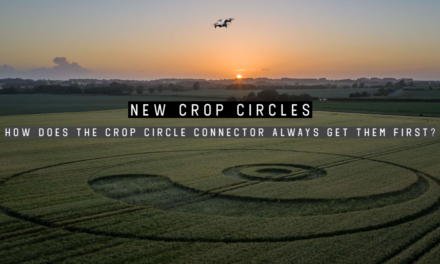The Croppie is regularly approached by its readers for information on crop circles, how to get personally involved with the phenomenon and the identities of the ‘best’ people to know. And after a while the discussion will almost always shift to the issue of how the circles appear and where they come from. The Croppie has given up on getting too involved in these conversations, but believes there are six key pieces of knowledge that everyone should take on board before entering the fields in whatever role they wish:
1. You get involved with crop circles by turning up
There is no set route to becoming a croppie. Your involvement can depend upon a number of factors, most notably your location and the amount of money and time you have to put towards your interest. If you can, get into the fields and experience crop circles first hand by visiting them. You’ll probably meet some interesting people, particularly on a warm summer’s day under the Wiltshire sun. If you can’t do that, there is no shame in being an armchair croppie: circles related social media is always an entertaining place. Just beware the inverse square law of crop circles; this dictates that the further a person is situated from Wiltshire, the less likely they are to know about what really happens in the field.
2. Answers to life’s big questions are found away from the fields
It can be disconcerting to see the amount of new croppies who come onto the scene looking for answers to some of life’s deep questions: Are we alone in the universe? Does the phenomenon prove the existence of extraterrestrials/God/Gaia/whatever? Do the crop circles relate to some bigger theory of everything?
People have been searching for the massive answers in the crop circles for more than thirty years. Perhaps you’ll find your own personal truths, but don’t expect to uncover factual information on life, the universe and everything.
3. Nobody forces you to adopt the outlook you have on the phenomenon
For many croppies their involvement with the phenomenon is a journey. They enter the fields seeking answers and, very often, their discoveries aren’t what they hoped for. Some circles enthusiasts get very upset at this point, but they would do well to remember that there was (and still is) a good amount of literature available detailing the history of the circles.
4. You cannot control the crop circles
The archives of cerealogy are filled with the tales of researchers, wannabe messiahs and whining manbabies who have attempted to impose their own view of how things should be in the crop circle world. These individuals always fail and frequently go a bit loopy in the process. The subject is far too big, and the people too diverse, to be controlled by any individual or their followers.
5. There is so much more to the crop circle phenomenon than the matter of origin
So many people come to the crop circle world looking for answers to big questions (see point two above) that they overlook everything else that crop circles can offer. The Croppie won’t list these things because if you’re here for the right reasons you’ll almost certainly find them for yourself. You may even make some discoveries which have eluded those who came to the fields before you.
6. ‘It’s just flattened corn’
Dave Chorley, one half of the famed Doug and Dave circle making pair, was right when he said of crop circles, ‘It’s just flattened corn’. In fact, if The Croppie was asked to name the one most important lesson to take from the circles, it would be this. It’s a phrase frequently repeated in these pages for a reason: It doesn’t matter how angry, upset, enthused or delighted someone becomes with the circles, these emotions relate to some flattened plants in a field. Think about it.





